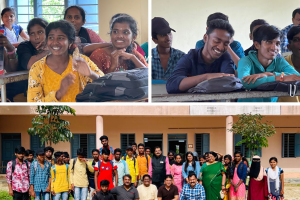In all our conversations on gender diversity, we often rope in the group that is fully vested in these initiatives – women. However, real results will depend on inviting the other side to the table.
There was palpable excitement in the air. Nandan Nilekani, the then CEO, was about to address the Infosys Women’s Inclusivity Network, “acronymised”, as we “acronymised” everything, to IWIN. The Management Council Room was jam-packed with lady Infoscions who had bustled in to secure the best available seats. Adding to the excitement was the topic itself – The Power of Networking, something everybody concurred was critical for women to grow intellectually and climb the corporate ladders of success.
Of course, it was relevant for men as well. Which is why the gentlemen Infoscions in the lobby were sulking as they had not gained entry into the “No standing space even for women, sir” conference room. Rushing in to catch the talk, I was accosted by one of them, a senior male colleague and dear friend. His rant at the “No Entry” was without malice. But when I gently brought it to his notice that it was after all an IWIN event, he gave me a comeback line which comes to haunt me even today. With a deep-throated laugh he proclaimed: “Hema, you can have your IWIN. But remember ultimately, WE WIN”.
While it is debatable whether this particular session should have had a gender-balanced audience, what my friend did gently was state the obvious – “If you want gender-inclusivity initiatives to succeed, don’t just woo the minority, carry the majority too.” Every time I am invited to an International Women’s Day event, or address a session championing gender diversity and cast my eyes across the predominantly estrogen-filled room, my wise colleague’s words come back to me.
Don’t get me wrong. I know it is good for minorities (which women are in many organizations) to huddle. This gives them both the critical mass and that “letting down their hair” time, akin to what gentlemen only clubs do for men. But when conferences, sensitization sessions and serious discussions to push the case for gender diversity are held in gender-biased environments, then both the input and the impact gets seriously diluted. It is common to see speakers and participants ruing this trend at conferences; but improvement takes work.
Nasscom’s conference on Diversity and Inclusivity, held annually since 2006, provides an interesting case study. This conference has worked hard at reducing this gap. Sucharita Eashwar, former senior director at Nasscom, has statistics to speak for this. “From ‘men as speakers only’ in 2006 we have steadily improved the participant mix. 2007 had under 2 % of the participants as men, 2008 had 6%, 2009 15% and most recently in 2010 we had 32%!”. (In 2015 the percentage continues to be around 30%).
But participation in conferences is only symptomatic. The question really is whether the nominators champion this? If men who are the majority at the decision-making and operational leadership levels in organizations, are not visibly seen to sponsor and implement gender diversity, these initiatives will remain a peripheral and nice-to-do task to comply with.
To get this buy-in it is critical that organizations evangelize the business benefits of diversity over and over, ad nauseum, to these decision makers and influencers. Ultimately that is what will be the strongest reason for embracing it. Organizations are taking interesting tacks to do this – talent pool availability, better retention indicators and the interesting one of how diversity at the workplace mirrors diversity of the customer and better market perspectives. Nokia’s program of embedding gender duality in product design, solution development and product marketing is a great example of this.
Analytics is a great way to understand the issues on the ground. Sometimes the reason for skewed gender ratios is not the most obvious. The case study of a leading consulting organization comes to mind. The selection model that had been adopted at the entry level was a totally gender-balanced one. But at partner selection time, the pool of eligible candidates was 1: 3 in favour of men. The usual reasons were trotted out: attrition, mommy tracks, hesitation to travel. But data ultimately proved each one wrong and gave the right reason. It was actually a question of assignment allocation. Men were getting allocated to the new economy assignments, women to the traditional ones – manufacturing, et al. Come partner selection time, there already were entrenched partners in the traditional lines of business, but not in the newer ones. And hence the skew!
Policies like work from home, crunched work weeks or flex timings alone are not enough to encourage gender balance. Managers must be trained in how to deploy them effectively. The success of these initiatives requires skill building, especially for front line managers who have to drive the implementation. The manager’s ability to reward for results and not just effort needs to be developed. This will provide a level-playing field for both genders and not put a lady team member who steps out early for babysitting duties at a disadvantage vis-à-vis her male peer who handholds the boss late into the evening without much else to show for results. But this also means the said manager needs to consciously develop planning, organizing, resourcing and time management skills.
Lastly, at the risk of repeating myself, let me emphasize the role of the CEO. Organizations take their cues from the corner office. The leader (and I am consciously using the masculine here) must be seen as gender inclusive – not just at work but also in the personal sphere. The question is not just of a working spouse. Infact, it goes much beyond that. In the final analysis this is the greatest catalyst or the biggest stumbling block in driving the message of inclusivity strongly through the organization.
Editor’s note: This article, now updated, first appeared in Mint in March 2011.
Hema Ravichandar is a strategic human resources consultant. She serves as an independent director and an advisory board member for several organizations. She was formerly the global head of HR for Infosys Ltd.




